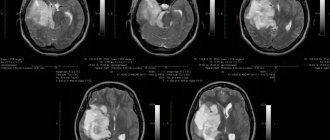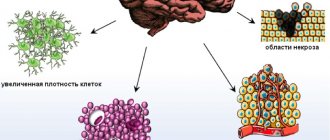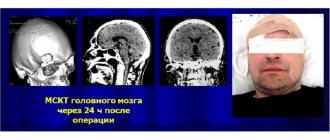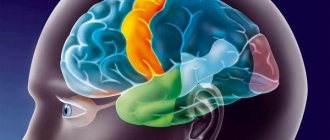A malignant brain tumor, often called brain cancer, is a neoplasm of modified cells that is characterized by relatively rapid growth and the ability to grow into neighboring tissues and other organs. This is an extremely dangerous pathology, since at an early stage, when it is quite easy to cope with, it is discovered only as a result of special studies. The disease can develop in a person of any age and gender; even cases of congenital neoplasms have been reported. As the tumor grows, it takes up more and more space in the skull, which leads to compression of other tissues and a gradual increase in intracranial pressure. Therefore, even a benign cell formation over time acquires a malignant course and can lead to death.
Kinds
Based on the method of tumor formation, oncologists distinguish between brain cancer:
- primary – formed directly from cells belonging to the organ;
- secondary, or metastatic - occurs when metastases from other organs of the body penetrate into the skull.
Primary neoplasms occur 3-4 times less frequently than secondary ones and account for approximately 1.5% of all cases of cancer. The overall incidence of cerebral tumors is 5-6%, and the risk of their development increases with age. In children, this disease is extremely rare - statistics record no more than 2.4 cases per 100 thousand population under the age of 18 years.
Depending on what tissue became the source for the neoplasm, the following types are distinguished.
- Astrocytomas (gangliomas), which develop directly in brain cells and account for up to 80% of all clinical cases.
- Meningiomas, the source tissue for which is the membranes of the brain, and their cells rarely acquire malignant characteristics, although the growth of tumors in any case negatively affects the functioning of the brain.
- Neuromas that grow from the myelin sheath of nerve fibers inside the skull.
- Pituitary adenomas form in the tissue of the pituitary gland and exhibit malignant features in rare cases.
Diagnosis of brain tumors
Symptoms of dysfunction of one or another part of the brain are an indication for contacting a neurologist. At the Yusupov Hospital, doctors conduct a comprehensive examination of the patient:
- Assessment of general status;
- Identification of neurological symptoms and signs of intracranial hypertension using an ophthalmoscopic picture of the fundus;
- Electroencephalography;
- And they use modern
- Computer and magnetic resonance imaging.
To resolve the issue of the possibility and feasibility of surgical intervention, oncologists at the Yusupov Hospital perform magnetic resonance imaging according to the standard, in three projections and in three modes (T1, T2 and FLAIR). If necessary, use additional MRI capabilities:
- MRI perfusion;
- Functional magnetic resonance imaging;
- MRI diffusion;
- Magnetic resonance spectroscopy.
If the study cannot be performed, contrast tomography without contrast and with contrast enhancement is performed. As part of an additional protocol, positron emission tomography with methionine is performed. If magnetic resonance imaging suggests an abundant blood supply to the tumor, neurosurgeons perform direct or computed angiography to optimize surgical tactics.
A brain biopsy is an invasive diagnostic procedure in which the surgeon removes a small sample of brain tissue for further examination under a microscope. At the Yusupov Hospital, doctors perform all biopsies recommended by the International Association of Oncologists and Neurosurgeons:
- A puncture biopsy of the brain, in which a small hole is drilled in the skull (a small sample of a tumor or brain tissue is taken through the hole or using a thin hollow);
- Stereotactic brain biopsy – removal of a small area of brain tissue or tumor using a minimally invasive method (the procedure is carried out under the control of magnetic resonance or computed tomography, high safety due to very precise movement of the needle;
- Open brain biopsy - removal of a sample of the brain during surgery.
To diagnose brain cancer, a study of the level of tumor markers is carried out:
- α-fetoprotein;
- PSA;
- SA-15.3;
- CYFRA-21.1.
The first diagnostic criterion for the presence of a malignant tumor in the body is an increase in the level of α-protein. The PSA tumor marker refers to tumor antigens produced by prostate cells. In men under forty years of age, its concentration should not exceed 2.7 ng/ml, four nanograms per milliliter, and in older people - 4.0 ng/ml. PSA levels increase when atypical cells from the prostate metastasize to the brain.
The level of tumor marker CA 15-3 is determined if breast cancer metastases to the brain are suspected. In women, the normal concentration of the tumor marker CA 15-3 does not exceed twenty units per milliliter. If the test value for this tumor antigen exceeds fifty units, one can think about the presence of cancer metastases from other organs to the brain.
The malignant tumor marker CYFRA 21-1 is examined if lung cancer metastases to the brain are suspected. Interference values of tumor marker H CYFRA 21-1 do not exceed 3.5 ng/ml.
All cases of brain cancer are discussed by professors and doctors of the highest category at a meeting of the Expert Council of the Yusupov Hospital. Leading neurosurgeons from partner clinics are invited to the consultation. The oncology clinic is equipped with modern equipment and staffed with specially trained personnel. This allows us to carry out all innovative operations at a high professional level and provide high-quality care in the postoperative period.
Symptoms
Signs of brain cancer are divided into general cerebral, i.e. manifested in all types of disease without exception, and focal ones, from the totality of which one can form a primary idea of the localization of the neoplasm.
Common symptoms of a brain tumor that appear as a result of increased intracranial pressure include:
- the appearance of constant headaches, which intensify with sudden movements of the head and are not relieved by medications;
- sudden dizziness, nausea and vomiting, fainting;
- feeling of constant fatigue, drowsiness;
- the appearance of problems with visual perception – blurred pictures, “sights”, hallucinations;
- violation of spatial orientation and coordination.
In turn, focal symptoms of brain cancer depend on the location of the tumor and allow localization of the pathology:
- in the forehead area - due to weakening of one half of the body, loss of smell, change in the patient’s character;
- in the temple area - for convulsions, speech disorders, developing forgetfulness;
- in the crown area - for speech impairment, loss of sensitivity of half the body;
- in the occipital lobe - due to loss of vision in one of the eyes;
- in the cerebellum - by vibration of the eyeball, lack of coordination of movements, spasm of the neck muscles;
- in the brain stem - due to unsteadiness of gait, disturbances in swallowing and difficulty speaking, weakness of the facial muscles.
In order not to miss the onset of the disease, if even one or two of the first signs of brain cancer appear, you must consult a neurologist and undergo an examination.
Brain cancer stages and prognosis
For most types of malignant neoplasms, the stage is determined depending on how far the disease has spread throughout the body. Brain tumors can only spread to other parts of the central nervous system and almost never spread to other organs. This is why brain tumors are not staged like most other types of cancer.
Brain cancer is a complex disease, making survival difficult to predict. For a brain tumor, the prognosis will depend on factors such as: your age, the type of tumor, its location and size, growth rate, the presence of gene mutations and other changes in the tumor cells, the effectiveness of the treatment and the general health of the body.
Taking into account all the factors, your doctor will be able to provide more accurate information. Typically, about 15 out of 100 people with brain cancer survive 10 years or more after diagnosis.
Causes and risk factors
As medical practice shows, the main cause of brain cancer is metastasis from other organs affected by the disease. For primary neoplasms, risk factors have been identified that increase the incidence of pathology:
- old age – 50 years and above;
- having a close relative with a brain tumor;
- negative impact of radioactive exposure;
- genetic pathologies;
- prolonged contact with certain chemicals;
- brain injury or concussion.
Having one or more of these symptoms does not mean that you will definitely get sick. However, in this case it is necessary to be especially careful and undergo examination if warning symptoms appear.
Brain cancer
Brain cancer is a malignant tumor in the brain area (that originated there initially and did not metastasize from another organ).
The brain is the main organ of the central nervous system, consisting of many interconnected neurons (nerve cells) and their processes.
Malignant brain diseases are very rare. Their symptoms, as a rule, are quite severe; treatment in most cases is impossible, which leads to rapid death.
Synonyms Russian
Brain cancer, polymorphic glioblastoma, malignant brain tumor.
English synonyms
Brain Cancer, Brain tumor, Glioblastoma.
Symptoms
Symptoms of brain cancer depend on the size of the tumor and the involvement of the affected parts of the brain. At first they are expressed to a minimal extent, then gradually intensify. The symptoms of brain cancer are similar to those of a stroke.
The most common symptoms of brain cancer are:
- headaches that become more severe and frequent over time,
- nausea, vomiting, especially early in the morning, which is associated with increased intracranial pressure,
- disturbance of attention, memory,
- lack of coordination of movements, clumsiness,
- weakness, fatigue,
- speech disorders,
- visual impairment – double vision, loss of peripheral (side) vision,
- hearing problems,
- gradual loss of sensation in an arm or leg,
- convulsions,
- behavior changes.
General information about the disease
Brain cancer is a malignant tumor of brain cells (this refers to the primary occurrence of a tumor in the brain, and not metastasis to the brain from cancer of other organs).
The brain is an organ of the central nervous system, consisting of many interconnected neurons (nerve cells) and their processes.
Malignant brain diseases are rare and usually occur in people over 50 years of age.
In brain cancer, normal brain cells transform into cancer cells. In a healthy body, cells, appearing in the required quantity, die off at a certain time, giving way to new ones. Cancer cells begin to grow uncontrollably without dying off in due time. Their accumulations form a tumor.
At this time, the causes of brain cancer have not been established; it may be associated with hereditary predisposition, exposure to certain occupational factors, and ionizing radiation.
The most common types of brain cancer are:
- Gliomas (glioblastoma multiforme, anaplastic gliomas) are the most common type. They arise from glia cells - the structural framework of the brain. The tumor develops quite quickly, leading to the death of the patient within approximately 12 months. Medulloblastoma. Occurs in the cerebellum, most often occurs in children, and can metastasize. Its symptoms are an unsteady gait and shaking movements of the limbs. Impaired outflow of cerebrospinal fluid leads to the development of hydrocephalus (excessive accumulation of cerebrospinal fluid in the cranial cavity). The prognosis is unfavorable.
- Primary lymphoma. This type of tumor is becoming more common. People with reduced immunity and AIDS patients are susceptible to it.
Who is at risk?
- Persons over 50 years of age.
- Those who have genetic mutations and hereditary predisposition.
- Those who were regularly exposed to toxins - substances used in oil refineries, chemical and rubber industries.
- Infected with HIV.
- Smokers.
- Exposed to ionizing radiation during radiation therapy or after the explosion of an atomic bomb.
Diagnostics
If brain cancer is suspected, a thorough neurological examination, magnetic resonance imaging and computed tomography of the brain are performed. A biopsy can confirm the diagnosis and determine the type of cancer.
In addition, a standard list of laboratory tests is performed in order to assess the general condition of the patient and the functions of the most important organs:
- general blood analysis,
- coagulogram,
- liver enzymes (alanine aminotransferase (ALT), aspartate aminotransferase (AST),
- electrolytes (potassium, sodium),
- creatinine, urea.
Instrumental research methods:
- computed tomography (CT) and magnetic resonance imaging (MRI) can detect a brain tumor, determine its size and location; MRI has higher sensitivity for tumor tissue;
- biopsy - removal of brain cells for subsequent examination under a microscope; Only a biopsy can determine the type of cancer.
Treatment
Treatment options for brain cancer depend on the type, size and location of the tumor, as well as the patient’s health. It usually includes surgery, chemotherapy and radiation therapy. If it is impossible to get rid of the tumor, palliative therapy is carried out - aimed at alleviating symptoms.
- Surgery. If possible, the tumor is removed, but most often the cancer is inoperable.
- Radiation therapy is the use of radiation to kill cancer cells. It is used when surgery is not possible or in combination with surgery. Radiation therapy can also be carried out in conjunction with chemotherapy.
- Chemotherapy is the use of drugs to kill cancer cells.
- Palliative therapy is aimed at improving the patient’s quality of life and relieving symptoms when treatment is no longer possible.
Prevention
There is no way to prevent brain cancer, but the risk of developing it can be somewhat reduced:
- it is necessary to avoid contact with radiation (especially those aimed at the head area), avoid exposure to toxic chemicals used in oil refineries, in the chemical, and rubber industries;
- no smoking.
Recommended tests
- Complete blood count (without leukocyte formula and ESR)
- Coagulogram No. 1 (prothrombin (according to Quick, INR)
- Alanine aminotransferase (ALT)
- Aspartate aminotransferase (AST)
- Potassium, sodium, chlorine in serum
- Serum creatinine
- Urea in serum
Stages
Cancer specialists distinguish four main stages characteristic of brain cancer.
- A small number of cells are affected, the size of the neoplasm is small, but it is already beginning to have an effect, expressed by a feeling of weakness, drowsiness, and periodic headaches without clear localization. If you do not neglect these symptoms of early stage brain cancer and undergo examination, then the detected tumor is cured in almost one hundred percent of cases.
- The tumor grows and spreads to neighboring tissues that are located next to it. Symptoms intensify, become more pronounced and noticeable. Some patients already at this stage develop convulsions and seizures similar to epileptic ones. The chances of successful surgical treatment remain, although not to the full extent.
- The growth of the tumor accelerates, it grows into healthy tissue, and there is a threat of death. A characteristic sign of the third stage is nystagmus - constantly moving pupils. There is a high probability that the tumor will be recognized as inoperable, in which case the patient receives only symptomatic treatment.
- The tumor affects all brain tissue located near it and rapidly increases in size. The patient's condition deteriorates sharply, possibly falling into a coma. At this stage, surgery to remove the pathological formation is impossible, and the prognosis is unfavorable. Therapy is aimed only at alleviating the patient's suffering.
In primary brain tumors, there are no metastases to other organs. A secondary disease most often develops due to the patient’s existing melanoma, kidney cancer, sarcoma, or colon tumor that metastasizes to the brain.
Prognosis for brain tumors
Until now, in people’s minds, any pathological neoplasm of the brain is associated with an incurable disease, but the latest methods for diagnosing and treating brain tumors in Israel prove that this is not the case at all.
A favorable prognosis largely depends on the complex of therapeutic procedures started in the early stages of the disease, as well as the degree of benignity of the tumor process. The key to effective treatment of a malignant brain tumor is timely detection and obtaining complete information about its size, location, and stage of development.
Patients from other countries often turn to cancer centers in Israel because domestic doctors have declared the tumor inoperable. And in this case, Israeli specialists, who have mastered the most advanced treatment technologies, work a real miracle, saving the patient, preserving his brain function and improving his quality of life.
Diagnostics
As a rule, diagnostic examinations for brain oncology are carried out as follows. You come for a consultation with a neurologist, who listens to complaints, conducts an examination and prescribes instrumental studies.
- CT scan of the head, which detects the presence of neoplasms already at the first stage.
- MRI of the brain with contrast, which is performed for early detection and localization of cancer.
- Angiography, which reveals abnormalities in the structure of the blood vessels of the brain.
- Scintigraphy, or radioisotope contrast study, is effective for the early detection of tumors.
- Lumbar puncture, through which a sample of tumor tissue is obtained for subsequent analysis.
The types of studies are selected by the doctor depending on the symptoms. The totality of the data obtained allows not only to identify a tumor, but also to accurately localize it, determine the size and stage of development of the disease, which is important for determining subsequent actions.
Treatment
Since the brain is an extremely specialized organ, treatment of tumors is the prerogative of a neurologist or neurosurgeon if it is decided that surgery is necessary. The choice of method depends on the location of the pathological formation and the stage of its development.
- Surgical intervention allows you to completely get rid of the disease only in some cases, when the tumor is located in a place convenient for penetration and affects a minimum of tissue. More often, surgery is performed to reduce the severity of symptoms.
- Chemotherapy can be administered not only to adults, but also to children; drugs are administered orally or by injection.
- Radiation therapy is usually needed to remove any remaining tumor that cannot be removed during surgery.
- Corticosteroids are prescribed to reduce tissue swelling and inflammation. They have no effect on malignant cells.
- Symptomatic medications, which include painkillers, anticonvulsants and antidepressants, are prescribed to make the patient feel better and reduce symptoms.
Rehabilitation
To return the patient to a normal lifestyle after treatment, the doctor may prescribe rehabilitation procedures depending on the nature and extent of brain damage.
- Physical therapy is necessary to restore motor coordination and muscle strength.
- Classes with a speech therapist are useful for speech disorders.
- Treatment by a psychologist or psychotherapist is required for patients with developed depression, memory and thinking disorders.
- Taking anticonvulsant medications to prevent epileptic seizures.
After completing treatment, you must remember that brain tumors can recur, and you need to undergo regular preventive examinations.










